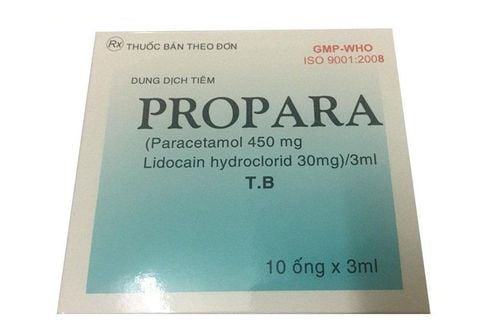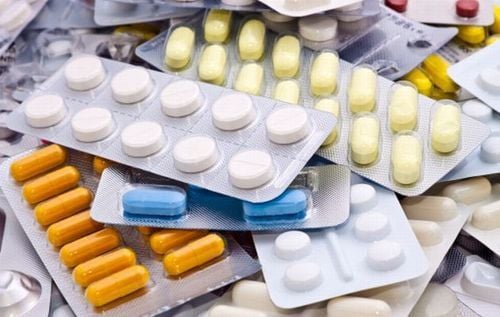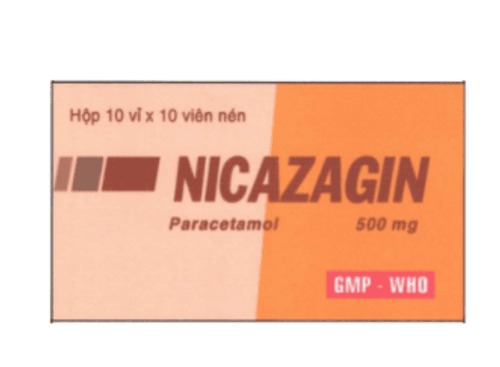This is an automatically translated article.
Paindol is used to quickly relieve the symptoms of fever, pain and discomfort caused by colds or some other diseases. Before using Paindol, you should consult a pharmacist or a specialist for safe and effective use of the drug.1. What is Paindol?
Paindol belongs to the group of pain relievers, antipyretics, non-steroid anti-inflammatory drugs, treating gout and bone and joint diseases. The drug is prepared in the form of long film-coated tablets, packed in boxes of 10 blisters x 10 long film-coated tablets.Ingredients Acetaminophen 500mg in Paindol is the active metabolite of phenacetin. Acetaminophen is effective in reducing pain and fever, but it is not effective in treating inflammation.
Acetaminophen with appropriate therapeutic doses has little impact on the cardiovascular and respiratory systems, does not change the acid - base balance or cause irritation, scratch or stomach bleeding as when using Salicylate. Acetaminophen also had no effect on platelets or bleeding time.
2. Indications for taking Paindol
Paindol is used to quickly relieve symptoms of fever, aches and discomfort such as headache, earache, toothache, body aches due to flu.3. Dosage, how to use Paindol
Paindol pain reliever is used orally with the following reference dose:
Adults and children over 12 years old: Take Paindol 500-1000mg every 4-6 hours as needed but not more than 4g/day. Children 6-12 years old: Paindol 250-500mg every 4-6 hours as needed, up to 4 times/day. Note:
Do not arbitrarily use Paindol to relieve pain for more than 10 days for adults and 5 days for children. Do not arbitrarily use Paindol to reduce fever in cases where the fever is too high (over 39.5 degrees Celsius), the fever lasts more than 3 days or the fever recurs without a doctor's prescription. The above Paindol dosage is for reference only. The specific dose of Paindol depends on the condition and the progression of the disease. To get the right dose of Paindol, you need to consult with your doctor or healthcare professional.
4. Paindol overdose and treatment
Paindol overdose symptoms :
Nausea and vomiting; Anorexia; Haggard; Stomachache ; High doses above 10g in adults and over 150mg/kg in children can cause complete and irreversible hepatocellular necrosis, metabolic acidosis, and encephalopathy. Emergency treatment:
Immediately transfer the patient to a qualified medical facility. Gastric lavage to eliminate the amount of drug taken. Take orally or intravenously the antidote N-acetylcysteine as soon as possible.
5. Contraindications to taking Paindol
Patients with anemia many times or heart, lung, kidney, liver disease. Patients with alcoholism, hypersensitivity to Acetaminophen. Contraindicated in patients with glucose-6 - phosphate dehydrogenase deficiency.
6. Paindol side effects
Occasional side effects:
Skin rash (commonly erythema); Allergic reactions, urticaria; More severe and may be accompanied by drug fever and mucosal lesions. Uncommon side effects:
Nausea and vomiting. Decrease in neutrophils, pancytopenia and white blood cells; Anemia. Kidney disease with long-term abuse. Rare side effects:
Hypersensitivity reactions. When experiencing side effects of Paindol, you need to stop using and notify your doctor or ask your loved ones to take them to the nearest medical facility for timely treatment.
7. Be careful when using Paindol
People with phenylketonuria - urinary and must limit the amount of phenylalanine put into the body should be warned that some Acetaminophen preparations contain Aspartame, because it can be converted in the stomach - intestines into phenylalanine after taking. Certain forms of Acetaminophen contain sulfites that can cause allergic-type reactions, including anaphylaxis and life-threatening or less severe asthma attacks in some people with hypersensitivity. Acetaminophen should be used with caution in patients with pre-existing anemia. Heavy drinking can increase the liver toxicity of Acetaminophen. Therefore, patients should avoid or limit alcohol consumption while using the drug. Acetaminophen should be used with caution in people with impaired liver or kidney function. Signs of serious skin reactions such as Stevens-Johnson syndrome (SJS), toxic skin necrosis (TEN), Lyell's syndrome or acute generalized exanthematous pustulosis (AGEP) may occur with use. medicine, so it is necessary to be careful and careful during use. Acetaminophen is the pain reliever of choice for pregnant women. However, use of Acetaminophen in late pregnancy has been associated with persistent wheezing in the newborn. Therefore, Acetaminophen should not be used too often for pregnant women. No adverse effects have been observed in breastfed infants when the mother is taking Acetaminophen. The amount of Acetaminophen distributed into breast milk is very small, so it is unlikely to cause harm to a nursing infant. The article has provided information about what Paindol is, dosage and precautions for use. Because Paindol is a prescription drug, patients should not use it on their own, but need to contact a doctor or a qualified person directly to get an appropriate prescription to ensure safety for health.













